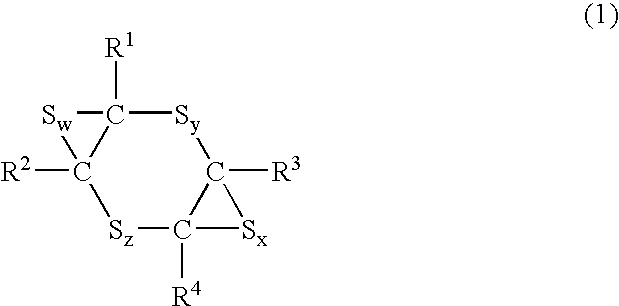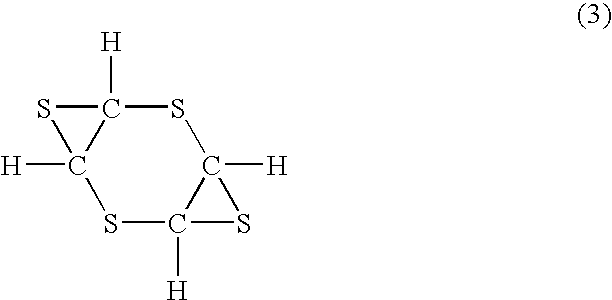Alicyclic compound for optical material
a technology of alicyclic compounds and optical materials, applied in the field of optical materials, can solve the problem of limited refractive index of materials obtained from these polyepisulfides to at most 1.73
- Summary
- Abstract
- Description
- Claims
- Application Information
AI Technical Summary
Benefits of technology
Problems solved by technology
Method used
Image
Examples
synthesis example 1
[0097]Into a reaction flask equipped with a thermometer and a calcium chloride drying tube, 381.4 g (2.0 mol) of toluenethiosulfenyl chloride and 1000 mL of chloroform were charged and cooled to −80° C. Stirring vigorously, a solution of 116.2 g (1.0 mol) of 1,4-dithiane-2,5-diene in 500 mL of chloroform was added dropwise. 1,4-Dithiane-2,5-diene was prepared by the method described in J. Am. Chem. Soc., 75, 2065 (1953). After the addition, the reaction was allowed to proceed at room temperature for 30 min. After adding a solution of 74.1 g (0.95 mol) of sodium sulfide in 500 mL of methanol, the reaction was allowed to further proceed at 50° C. for one hour. The reaction product was added with 1000 mL of water and 1000 mL of chloroform to collect the lower chloroform layer, followed by drying and evaporation. The residue was purified by distillation and silica gel column chromatography to obtain 45.2 g of the product.
[0098]The product was identified as 1,2:4,5-diepithio-3,6-dithiacy...
example 1
[0103]1,2:4,5-Diepithio-3,6-dithiacyclohexane (100 parts by weight) prepared in Synthesis Example 1 and 0.02 part by weight of N-methylimidazole (catalyst) were mixed to a uniform liquid, which was then filtered through a PTFE filter (0.5 μm pore size), cast into a mold for flat lens of 2.5 mm thick, and cured by polymerization in an oven by raising the temperature from 10° C. to 120° C. over 22 h to produce a lens. The obtained lens was excellent in heat resistance and physical properties, and showed an excellent transparency and surface condition. The refractive index was 1.78 and the Abbe's number was 30.
PUM
| Property | Measurement | Unit |
|---|---|---|
| refractive index | aaaaa | aaaaa |
| temperature | aaaaa | aaaaa |
| temperature | aaaaa | aaaaa |
Abstract
Description
Claims
Application Information
 Login to View More
Login to View More - R&D
- Intellectual Property
- Life Sciences
- Materials
- Tech Scout
- Unparalleled Data Quality
- Higher Quality Content
- 60% Fewer Hallucinations
Browse by: Latest US Patents, China's latest patents, Technical Efficacy Thesaurus, Application Domain, Technology Topic, Popular Technical Reports.
© 2025 PatSnap. All rights reserved.Legal|Privacy policy|Modern Slavery Act Transparency Statement|Sitemap|About US| Contact US: help@patsnap.com



